Many gardeners are beginners. I see this from the number of gardening bloggers who say so, and from my experience living in and about a large city where people work constantly and are afraid to plunge into having much of a garden, because they don’t know how to put one together or how to look after a garden once they have it.
People constantly say that they don’t want to be tied to the maintenance of a garden–they work, they are away in the summer–and that is why they give up the joy of having their own personal piece of paradise.
One easy way to have a garden look after itself is to know what the conditions of the various areas of your property are and to plant only plants that love to be in those conditions. An experienced garden designer would never do otherwise!
Another is to choose mainly perennials: these plants grow back every year and do not need to be replanted annually.
Having said that, the following is my list of top plants for the beginning gardener. These are plants that are visually rewarding to grow, seldom if ever susceptible to pests or disease and thrive with little or no care.
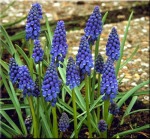 Grape Hyacinth Tiny but tough, this one will multiply very prolifically and can get carried away. However, it looks best in masses and is easy to pull out if necessary. Extras may be thrown into your spring planters as well.
Grape Hyacinth Tiny but tough, this one will multiply very prolifically and can get carried away. However, it looks best in masses and is easy to pull out if necessary. Extras may be thrown into your spring planters as well.
Crocus The easiest to care for of all the spring bulbs. While tulips and other beauties may weaken over time, crocuses will multiply (politely, though: not so as to become a nuisance). You can plant them in gardens or under your lawn for spring drifts of flowers before lawn mowing season begins.
Lily of the Valley The heavenly scent of this shade-loving classic will have you looking forward to their nodding, white bells every spring. They are charming and fragrant if cut for indoors, but keep children away from them, as they are toxic if ingested.
Lilac Plant lots of varieties for their beautiful and aromatic blossoms in May and June. Your children will forever associate their presence with the coming end of the school year. Once your plants are large enough you will look fondly forward to cutting them to bring their scent indoors each spring–and cutting flowers simply encourages more blooms next year! (However lilacs don’t generally require pruning to bloom.)
Bleeding Heart Lush and lilting by May or June, with a long period of bloom, these classic beauties look delicate but belie their carefree nature. You can clip them for arrangements alone or as a complement to dramatic flowers like peonies or lilacs. They are extremely winter-hardy, thrive in shady spots and their languid leaves provide contrast to other foliage after the main bloom period eventually ends. As long as they don’t completely dry out, the only care they will need is to have their dead stalks cut back for tidiness after they turn yellow in autumn. Bonus: they are also easy to divide once their root systems become large.
Peony If you don’t have these large-flowered stunners in your garden, you don’t know what you are missing. Cut them and bring them indoors for drama and scent. You will be in love for life. Deadhead them after blooming, but if you don’t, they don’t care! You will still get huge, fragrant blooms again next year. Various pinks, red or white, you will want to cut off their spent stalks in fall, just to tidy.
Peonies are incredibly long-lived and the number of old farmhouses in Ontario with hundred-year-old peony beds blossoming away are a testament to how easy these perennials are to maintain.
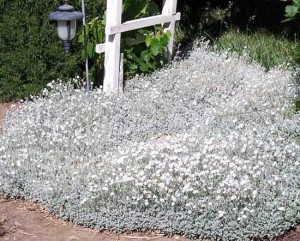 Snow-in-Summer The reason I love this Ontario favourite is that its tiny, fuzzy silver-green leaves are a foil or complement to all the taller plants, and it fills in the edge of a garden beautifully. It will not seed all over your garden but creep vigorously in the area you plant it. Covered with a mass of brilliant, white, tiny flowers in June it s low-growing but still dramatic at a distance. Virtually no care is required, but you may have to pull it out around the edges if it creeps too far into other plants.
Snow-in-Summer The reason I love this Ontario favourite is that its tiny, fuzzy silver-green leaves are a foil or complement to all the taller plants, and it fills in the edge of a garden beautifully. It will not seed all over your garden but creep vigorously in the area you plant it. Covered with a mass of brilliant, white, tiny flowers in June it s low-growing but still dramatic at a distance. Virtually no care is required, but you may have to pull it out around the edges if it creeps too far into other plants.
Creeping Phlox Similar to Snow-in-Summer but with greener leaves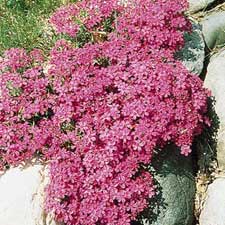 , this is a ground-hugging mass of white, mauve or pink blossoms in late spring to early summer. It typically re-blooms without provocation with a less intense show of flowers later in the summer. Use them to edge a perennial border or mass various colours on a slope, always in a sunny area.
, this is a ground-hugging mass of white, mauve or pink blossoms in late spring to early summer. It typically re-blooms without provocation with a less intense show of flowers later in the summer. Use them to edge a perennial border or mass various colours on a slope, always in a sunny area.

Irises are hardy, stunning and easy to grow
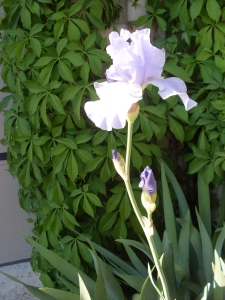
These enormous blue irises tower about four feet tall but other varieties are as small as eight inches tall.
Iris Another “wow” flower in your garden. There are so very many colours, heights and varieties of iris that they cover a multitude of uses in the garden, and they are also beautful cut (if short-lived). They grow from a thick rhizome and multiply slowly. Divide them every few years for more, and to keep them healthy. Graceful Siberian Irises are a tough and resilient top choice.
Day Lilies These casual favourites look great in clumps beside hostas or other complementary plants, or in large, undulating drifts for great drama. There are many cultivars available now for bloom at almost any point in the summer, with plain or ruffly leaves and in many, many 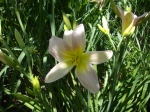
colours, so try a few. You can mix them together for a longer show in one area, and their straplike, arching leaves look great beside many other plants even when they are out of bloom.
Hosta cultivars Plant them in shade. Older varieties are typically most reliable but it is hard to go wrong, and the range of sizes (from plants you could lose your pets under like “Sum and Substance” or “Titanic”, to tiny, rounded or pointy-leaved varieties), colours and leaf patterns is truly staggering! Want more? Simply drive your shovel through the middle of your larger plants and re-plant new sections (subject to patents of new varieties). They look especially lovely under a row of hydrangeas!
Tip: plant hostas near grape hyacinths, tulips and other bulbs and their leaves will grow up and cover the leftover, dying debris when the bulbs finish blooming!

“Cool and Green and Shady”, large, arching Solomon’s Seal in bloom forms and backdrop to Hosta, “Big Mama” and Hosta Undulata “Variegata”
Solomon’s Seal This could be may all-time favourite plant, although saying that is a bit like choosing a favourite child. If you want your garden to look lush, as though you have the greenest thumb in town, then start with one or two of these. Each year, they double neatly in the number of stems, but never reach out of their spot to compete with neighbouring plants. I have grown them in sun or shade, and even under the evil, toxic black walnut tree next door. Arching like a fern, yet more lush and drought-resistant, they complement any other plant you want to put next to them.
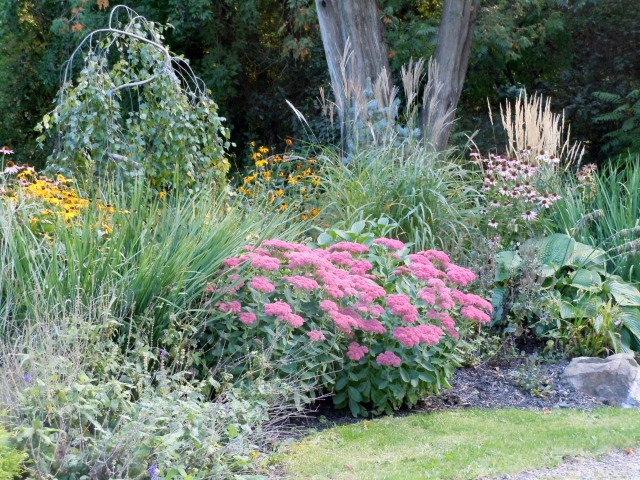
Sedum, Autumn Joy blooms with grasses in this late summer garden. For more on this garden, click here.
Sedum “Autumn Joy” Regular readers will probably roll their eyes: I show you this plant in every season: cute, fleshy clumps of leaves in spring; fresh, green
flower heads forming in summer and pink flower heads darkening to a burgundy-brown throughout late summer and fall, followed by their substantial, brown heads holding up pretty formations of snow throughout the winter! How could I not?
Need more? Pull off any leaf or piece of plant, put it in soil and water it! Full sun to light shade, this plant is a performer! Cut back in late winter or early spring to let new growth show.
So, those are the plants. Of course, start your garden with a good bed of quality topsoil for best results. You will need to weed but if you mulch bare soil you can minimize weeding.
Avoid fussing, staking, heavy fertilizing and losing blossoms next year if you neglect to deadhead this year: Start your garden with these plants and you will enjoy your success and your free time.
What are your favourite easy-care plants? If you have special favourites to recommend, please share below.
Click the follow button at top right to get gardening tips and inspiration in your inbox!

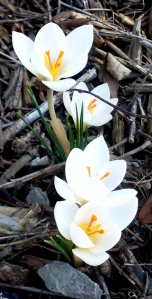
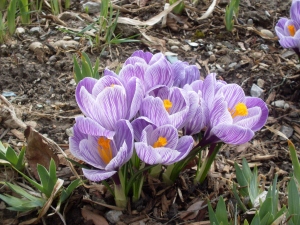
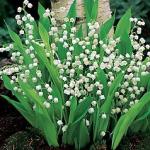
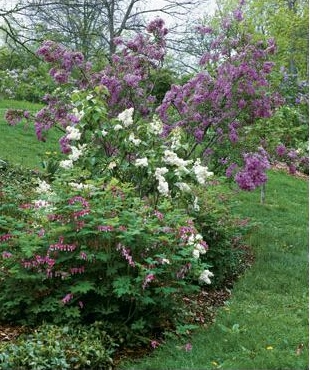

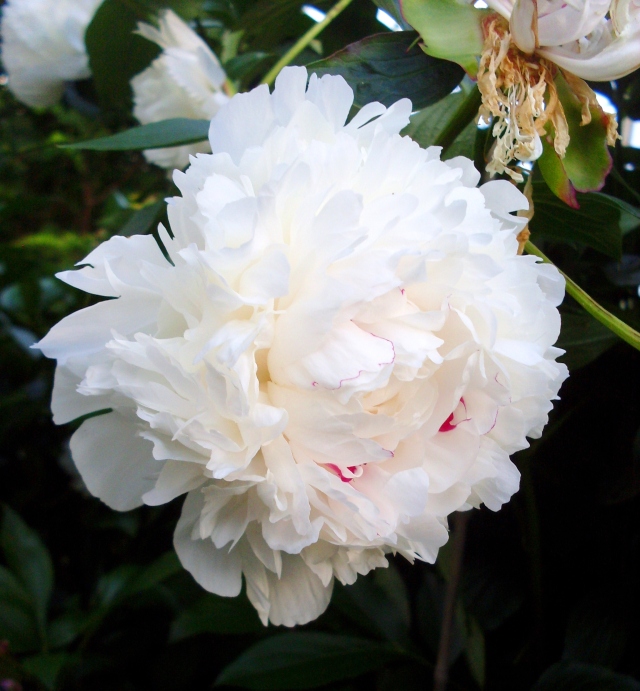
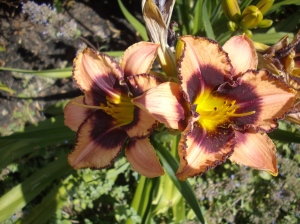
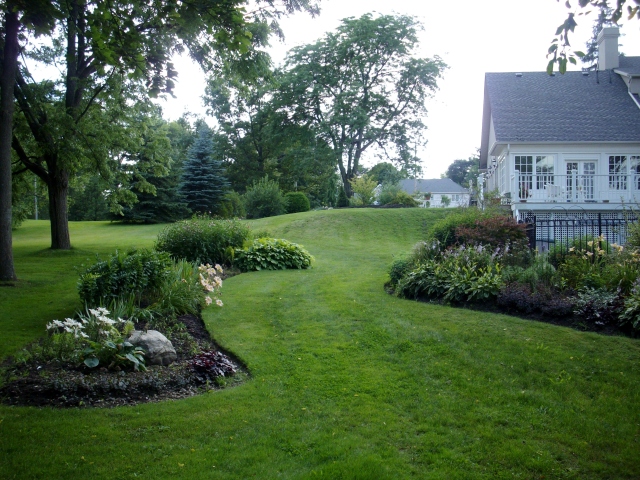
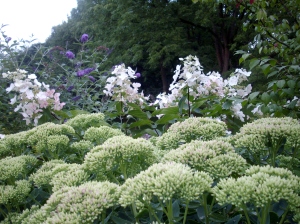
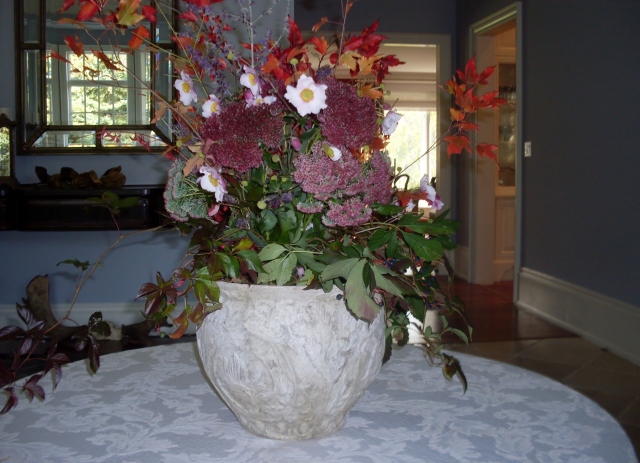




Reblogged this on Old School Garden.
Thanks for the great tips! I am a hopelessly horrible plant person but these are great ideas for when I finally put some time into sowing myself a garden, and especially when I leave the yard-less apartment life. x
This was one of the best blogs of flower garden information that I have read in a very long time. Thanks so much for all of this information. I am hoping to get a few of those varieties into the ground this year, and to get some out. I need to downsize my iris garden, but I am not sure I have the strength to get all of them out before it is too late.
Thank for that feedback–I was just thinking about you–haven’t been on my blog as much as I’d like to and am out of touch! Having the strength to meet all the deadlines a garden imposes can be a challenge, can’t it?
No doubt. As much as I have complained about the weather this year, it actually is better because I can’t get to the garden until almost June this year, so it sort of works out.
Haha–true. Last year I had everything weeded out and all organized so early–then the growing season was so long that it actually required far more time and labour to keep it all under control!
Beginner gardening tips are just what I need; whatever the opposite of a green thumb is, I have it! 🙂 I live in a small condo and don’t have room for much more than a windowbox. Do you have any suggestions for a plant newbie like me? (The box gets medium to full sun, if that helps).
succulents !!! lots of joy, almost no work ! if you want more info just ask ok ?
Thanks for sharing that great idea.
You’re welcome, I am a great fan of cacti and succulents as you perhaps noticed in my blog
🙂 Yes, I did!
For a window box or rectangular planter I like to get three things going on: something that trails down over the edge like an ivy; something low and mounding; and one or two taller feature plant varieties. Annuals are usually best for planters.
For trailing, I like the hedera helix varieties with white edges to contrast other plants but if you are in full sun you could use verbena, trailing geraniums or fuzzy licorice plant.
For the taller plant you can’t go wrong with annual geraniums which are reliable and rewarding for a beginning gardener, but mixing in herbs is also fun and useful for cooking. Certain grasses are also nice in sun for a more modern effect.
In between for something low you can put in pansies at this time of year if you are in a cold area, or any of the many annuals sold by nurseries for full sun that either trail a bit and are under six inches tall. It depends on your colour preferences but try to make all the plants contrast each other in leaf size, texture and leaf colour.
Even some burgundy foliage is a beautiful contrast.
If it’s cold right now, II would put in bulbs that are just set to open such as hyacinth, daffodil or tulips, perhaps with pansies and even ivy.
I agree with gwenniesgarden that succulents are an easy-care solution if you like the neat, modern look they give.
Hi amb–I posted a reply to your question but I notice it didn’t come up right under your question so I don’t know if you got it. If not, check back and scroll down in the comments under your question and you will eventually come to my long-winded answer!
Good post. You did select a group that is easy peasy for newbies. But a few you listed will need dividing often because they are so easy to grow. Newbies don’t always know to do it.
That is true, though these ones take some time to multiply that much and hopefully gardening skills will follow by then! Perhaps I should post on dividing them!
WOW, I had almost all the same plants but my yard sure never looked like that. Stunning!
You are so kind! Thank you.
Wonderful post and so unbelievable photos. We had in our old house on countryside small flower garden and I picked here photo from Bleeding Heart which I love very much.
I’m glad you enjoyed and thank you. Flowering plants make a lovely memory of a home or a person who gave them to you, don’t they?
What a lovely and practical post! I loved the garden photographs, too. Some of these plants I hadn’t really considered adding to my (new) garden, but I’m going to reconsider now. Thank you! Dana
Thank you–so good to get this feedback. I really think reducing maintenance is the biggest issue most people have!
This is a seriously great post. Very informative and perfect for those who think gardening is out of their skill set. I love the day lilies. In spite of my name, I’ve found that indoor irises are difficult to grow. They definitely thrive better outdoors (or at least for me).
I’m so glad to get feedback that you find the post useful–I always feel sorry that so many people think that gardening is too hard or too much work, so they don’t have a real garden. I have to admit that I’ve never tried irises indoors. There is a large difference between indoor gardening me, and outdoor gardening me!
Have a lovely weekend.
I am so impressed with your Solomon’s Seal! I didn’t realize they got so big! Too bad so many people think that gardens are such high maintenance. Good post.
Thanks–yes, it does seem sad not to have a garden just because of that perception.
Beautiful plants and very inspiring for any gardener-beginner or otherwise!
Thank you!They are my babies.
Thanks for the wonderful information–I need to add more easy-to-care-for plants in my gardens.
You’re welcome! I think our ancestors 100 years ago probably ONLY did easy-care plants!
I love peonies! 🙂 I agree, when we choose the right plants for the location, gardening, especially with perennials, is so easy! and pretty! Nothing says “great neighborhood” better than a lovely landscaping.
All true, and your comment about neighborhoods is absolutely right! It impacts property value.
What a great post! I love peonies too!
Glad you enjoyed and happy Spring.
Wow. I have most of these. I also love sweet woodruff. It’s such a happy little thing. Do you know how to properly prune a lilac? I bought a dwarf lilac, which is now beyond my 5’5″ height. When and how do I prune it for maximum loveliness?
People say just clip bouquets for indoors and that is a great way to encourage them. In addition, you can clip off the blossoms once they are done–I have a dwarf lilac that’s not as big as yours, which will re-bloom later in the year, so deadheading that one is rewarding.
You can also prune more seriously if you need to reduce the size–just prune out badly-shaped and very old branches. You can take out large and old ones right from the ground to re-invigorate a plant but be careful that the shape will still look good. Or, just prune back the taller stems below the height you are looking for. I would always prune a lilac very close to the bloom season so as not to disrupt next year’s blooms.
Thank you! I’ve put the information in a sticky note!!
I would agree whole-heartedly with most of your recommendations but would seriously disagree with a couple: Peonies have such a very short period of interest and their foliage isn’t all that great once summer arrives. You have also selected plants for very different conditions, which biginners wouldn’t realise; but I do like your island bed of Hostas and Salomon’s Seal, it looks perfect. Christina
I think your climate may have a different effect on the peony foliage than ours–I knew some wouldn’t agree with the peonies (I was thinking they sometimes need a few stakes) but they are incredibly easy to grow forever–at least here–and there isn’t much that does that in this area. Also, never any sign of disease or significant pests and, personal taste excepted, they are very dramatic and stunning during a period with not that much else going on. I am a peony lover, for sure.
I would have put only Day Lily into the easy to grow/care for plants. The ones I always recommend are golden pothos and heartleaf ivy. They are virtually impossible to kill. Cactus and succulents are good, too.
Haha, well, I think that reflects the difference in our climates! Those are only houseplants in my neck of the woods and would die almost immediately in this climate. I’m sure that what’s easy to grow in the Toronto climate probably has issues in your climate–even the Canadian west coast has completely different climate issues for plants from here.
Hi Leslie! Check out this link because it`s for you!
http://sylviesfashionsecrets.com/2013/05/17/wordpress-family-award/
Have a great day! 🙂 Sylvie
Wonderful suggestions and the photos are quite amazing. I really appreciated your information.
Thanks so much!
Still haven’t done much with my garden, but I will surely keep all these in mind. Thank you so much for the tips! 🙂